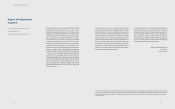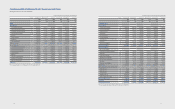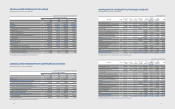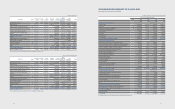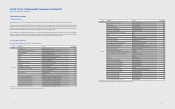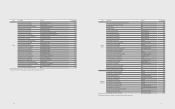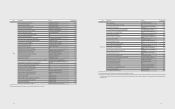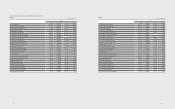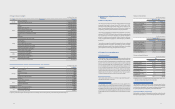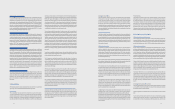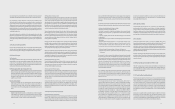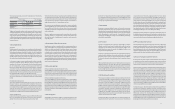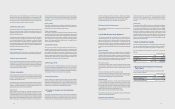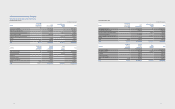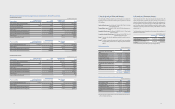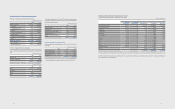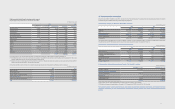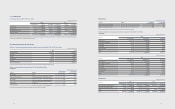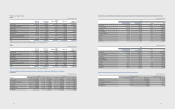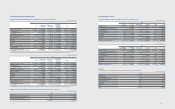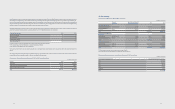Samsung 2012 Annual Report Download - page 34
Download and view the complete annual report
Please find page 34 of the 2012 Samsung annual report below. You can navigate through the pages in the report by either clicking on the pages listed below, or by using the keyword search tool below to find specific information within the annual report.
income and expenses are translated at the rate on the dates of the transactions; and
all resulting exchange dierences are recognized in other comprehensive income.
On consolidation, exchange differences arising from the translation of the
net investment in foreign operations are recognized in other comprehensive
income. When a foreign operation is partially disposed of or sold, the exchange
dierences that were recorded in equity are reclassied as part of gains and losses
on disposition in the statement of income. When the Company loses control over
foreign subsidiaries, the exchange differences that were recorded in equity are
reclassified in the statement of income during the period when the gain or loss is
recognized in prot or loss.
Any goodwill arising on the acquisition of a foreign operation and any fair value
adjustments are treated as the foreign operation’s assets and liabilities. The goodwill
is expressed in the foreign operation’s functional currency and is translated at the
closing rate. Exchange differences should be recognized in other comprehensive
income.
2.5 Cash and Cash Equivalents
Cash and cash equivalents include cash on hand, deposits held at call with banks,
and other short-term highly liquid investments that are readily convertible to a
known amount of cash and are subject to an insignicant risk of change in value.
2.6 Financial Assets
(A) Classication
The Company classies its nancial assets in the following categories: at fair value
through prot or loss, loans and receivables, available-for-sale, and held-to-maturity
investments. The classification depends on the terms of the instruments and
purpose for which the nancial assets were acquired. Management determines the
classication of its nancial assets at initial recognition.
(1) Financial assets at fair value through prot or loss
Financial assets at fair value through prot or loss are nancial assets held for
trading. A nancial asset is classied in this category if acquired principally for the
purpose of selling in the short-term. Derivatives not subject to hedge accounting
and derivatives separated from financial instruments such as embedded
derivatives are also categorised as held for trading. Assets in this category are
classied as current assets.
(2) Loans and receivables
Loans and receivables are non-derivative financial assets with fixed or
determinable payments that are not quoted in an active market. They are
included in current assets, except for those with maturities greater than 12
months after the end of the reporting period which are classied as non-current
assets.
(3) Available-for-sale nancial assets
Available-for-sale nancial assets are non-derivatives that are either designated
in this category or not classied in any of the other categories. They are included
in non-current assets unless an investment matures or management intends to
dispose of it within 12 months of the end of the reporting period.
(B) Recognition and measurement
Regular purchases and sales of financial assets are recognized on the trade date.
Investments are initially recognized at fair value plus transaction costs for all nancial
assets not carried at fair value through prot or loss. Financial assets carried at fair
value through prot or loss are initially recognized at fair value, and transaction costs
are expensed in the statement of income. Available-for-sale financial assets and
financial assets at fair value through profit or loss are subsequently carried at fair
value. Loans and receivables and held-to-maturity investments are subsequently
carried at amortized cost using the eective interest method.
Gains or losses arising from changes in the fair value of the nancial assets at fair
value through profit or loss, including interest income, are presented as financial
income in the statement of income in the period in which they arise. Dividend
income from nancial assets at fair value through prot or loss is recognized as other
non-operating income in the statement of income when the Company’s right to
receive payments is established.
Changes in the fair value of monetary and non-monetary securities classified as
available-for-sale are recognized in other comprehensive income. When securities
classified as available-for-sale are sold or impaired, the accumulated fair value
adjustments previously recognized in equity are transferred to the statement of
income under other nonoperating income or other expense items.
Interest on available-for-sale financial assets and held-to-maturity financial assets
calculated using the effective interest method is recognized in the statement of
income as part of nance income. Dividends on available-for-sale nancial assets are
recognized in the statement of income as part of other non-operating income when
the Company’s right to receive payments is established.
(C) Osetting nancial instruments
Financial assets and liabilities are offset and the net amount reported in the
statement of nancial position when there is a legally enforceable right to oset the
recognized amounts and there is an intention to settle on a net basis, or realize the
asset and settle the liability simultaneously.
(D) Derecognition of nancial assets
Financial assets are derecognized when the contractual rights to the cash ows from
the financial asset expire, when the Company transfers the contractual rights to
receive the cash ows of the nancial asset and substantially all the risks and rewards
of ownership, or when the Company neither transfers nor retains substantially all the
risks and rewards of ownership of the nancial asset and has not retained control of
the nancial asset.
Financial liabilities that arise through a transfer of receivables in factoring
arrangements with recourse do not qualify for derecognition since the Company
retains substantially all the risks and rewards associated with the receivables.. Such
liabilities are classified as short-term borrowings in the consolidated statement of
nancial position.
2.7 Impairment of Financial Assets
(A) Assets carried at amortized cost
The Company assesses at the end of each reporting period whether there is objective
evidence that a financial asset or group of financial assets is impaired. A financial
asset or a group of nancial assets is impaired and impairment loss is recognized
only if there is objective evidence of impairment as a result of one or more events
that occurred after the initial recognition of the asset or group of nancial assets (a
‘loss event’) and that loss event (or events) has an impact on the estimated future
cash flows of the financial asset or group of financial assets that can be reliably
estimated.
The following represent some of the factors that could lead the Company to assess
that there is objective evidence that a nancial asset or group of assets is impaired:
- signicant nancial diculty of the issuer or obligor;
- delinquency in interest or principal payments;
- the lender, for economic or legal reasons relating to the borrower's financial
diculty, grants to the borrower a concession that the lender would not otherwise
consider;
- it becoming probable that the borrower will enter bankruptcy or other nancial
reorganisation;
- the disappearance of an active market for that nancial asset because of nancial
diculties; or
- observable data indicating that there is a measurable decrease in the
estimated future cash flows from a group of financial assets since the
initial recognition of those assets, although the decrease cannot yet
be identified with the individual financial assets in the group, including:
1) adverse changes in the payment status of borrowers in the group; or
2) national or local economic conditions that correlate with defaults on the assets
in the group.
The amount of the loss is measured as the dierence between the asset’s carrying
amount and the present value of estimated future cash flows (excluding future
credit losses that have not been incurred) discounted at the nancial asset’s original
eective interest rate. The carrying amount of the asset is reduced and the amount
of the loss is recognized in the consolidated statement of income. In cases of
floating rate financial assets, the amount of the loss will be computed using the
present eective interest rate determined by the contract. As a practical expedient,
the Company may measure impairment on the basis of an instrument’s fair value
using an observable market price.
If, in a subsequent period, the amount of the impairment loss decreases and the
decrease can be related objectively to an event occurring after the impairment
was recognized (such as an improvement in the debtor’s credit rating), the reversal
of the previously recognized impairment loss is recognized in the consolidated
statement of income.
(B) Financial Instruments Classied as Available-for-sale
The Company assesses at the end of each reporting period whether there is
objective evidence that a nancial asset or a group of nancial assets is impaired.
Debt instruments are accounted for using the provisions described in (1). In the
case of equity investments classied as available-for-sale, a 20% or greater decline
in the fair value of the security below its cost or a continuous decline for more than
6 months is also evidence of impairment. If any such evidence exists for available-
for-sale nancial assets, the cumulative loss – measured as the dierence between
the acquisition cost and the current fair value, less any impairment loss on that
financial asset previously recognized in profit or loss – is removed from equity
and recognized in the consolidated statement of income. Impairment losses on
equity instruments recognized in the consolidated statement of income are not
reversed through the consolidated statement of income. If, in a subsequent period,
the fair value of a debt instrument classied as available-for-sale increases and the
increase can be objectively related to an event occurring after the impairment
loss was recognized in prot or loss, the impairment loss is reversed through the
consolidated statement of income.
2.8 Trade Receivables
Trade receivables are amounts due from customers for merchandise sold or
services performed in the ordinary course of business. If collection is expected in
one year or less (or in the normal operating cycle of the Company if longer), they are
classied as current assets. If not, they are presented as non-current assets. Trade
receivables are recognized initially at fair value and subsequently measured at
amortized cost using the eective interest method, less provision for impairment.
2.9 Inventories
Inventories are stated at the lower of cost and net realizable value. Cost is
determined using the average cost method, except for materials-in-transit. The cost
of nished goods and work in progress comprises design costs, raw materials,
direct labor, other direct costs and related production overheads (based on
normal operating capacity). It excludes costs of idle plant and abnormal waste. Net
realizable value is the estimated selling price in the ordinary course of business, less
applicable variable selling expenses.
Inventories are reduced for the estimated losses arising from excess, obsolescence,
and decline in value. This reduction is determined by estimating market value based
on future customer demand. The losses on inventory obsolescence are recorded as
a part of cost of sales.
2.10 Disposal Groups Classied as Held for Sale
When the carrying amount of certain assets and liabilities are expected to be
recovered through sale and the sale of a disposable group is highly probable, such
assets and liabilities are classied as held for sale and measured at the lower of their
carrying amount and fair value.
2.11 Property, Plant and Equipment
Property, plant and equipment are stated at cost less accumulated depreciation
and accumulated impairment losses. Historical cost includes expenditures that are
directly attributable to the acquisition of the items. Subsequent costs are included
in the asset’s carrying amount or recognized as a separate asset, as appropriate,
only when it is probable that future economic benefits associated with the item
will ow to the Company and the cost of the item can be measured reliably. The
carrying amount of those parts that are replaced is derecognized and repairs
and maintenance expenses are recognized in prot or loss in the period they are
incurred.
Depreciation on tangible assets is calculated using the straight-line method to
allocate their cost to their residual values over their estimated useful lives. Land is
not depreciated. Costs that are directly attributable to the acquisition, construction
or production of a qualifying asset, including capitalized interest costs, form part of
the cost of that asset and are amortized over the estimated useful lives.
6564


